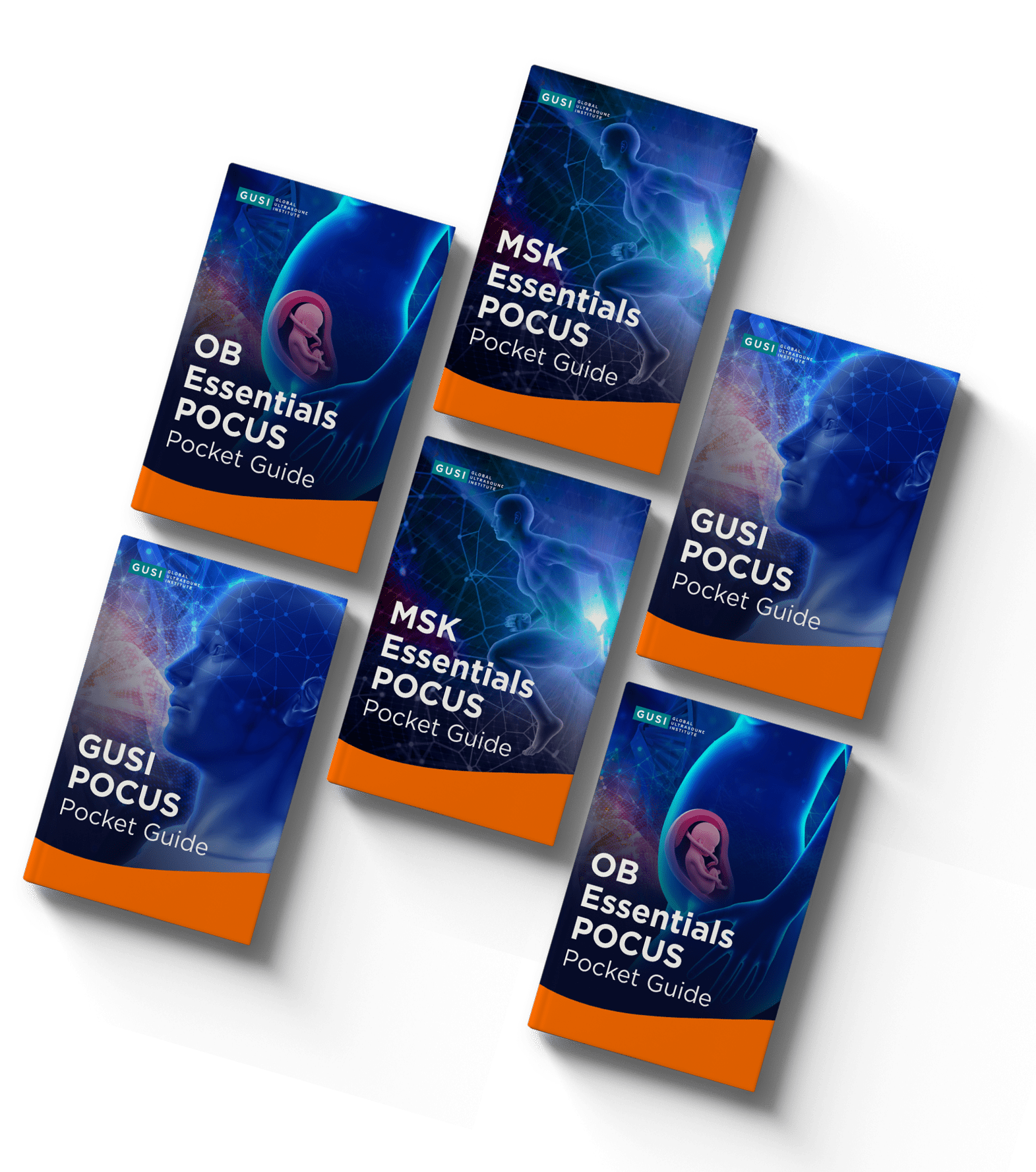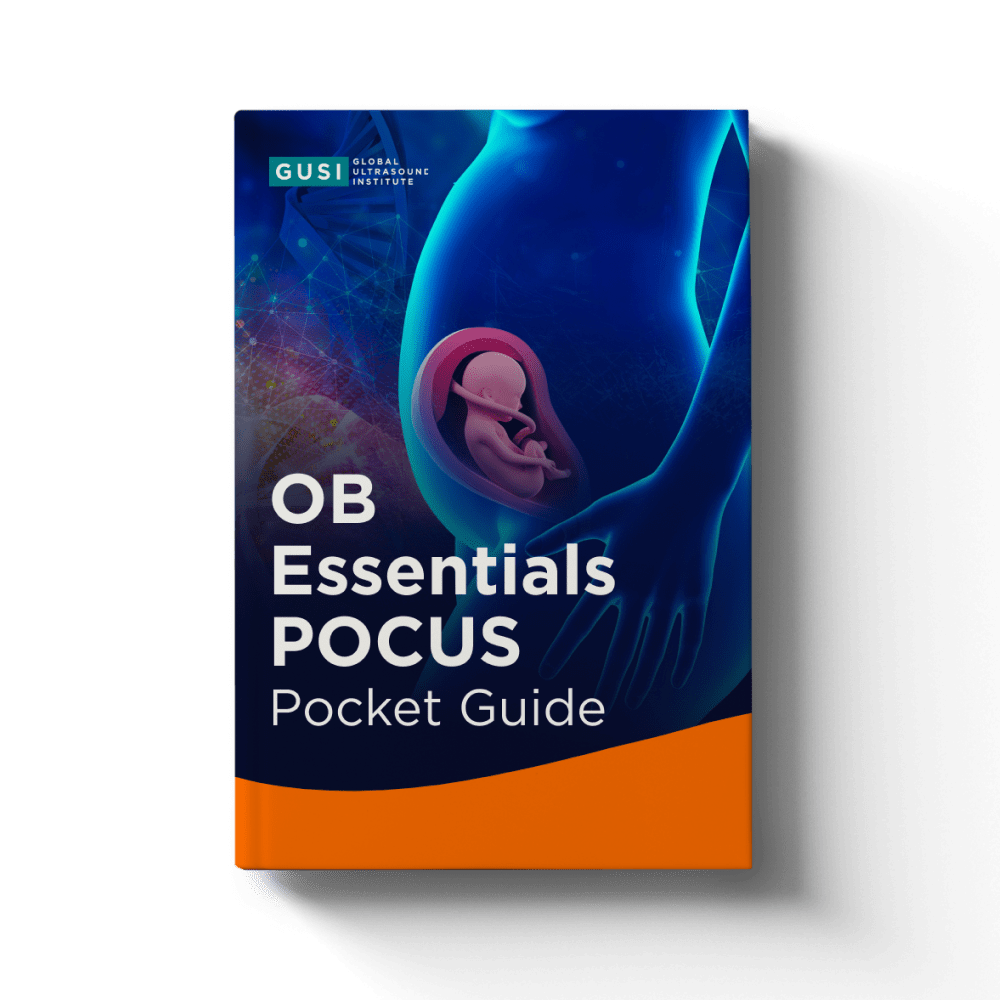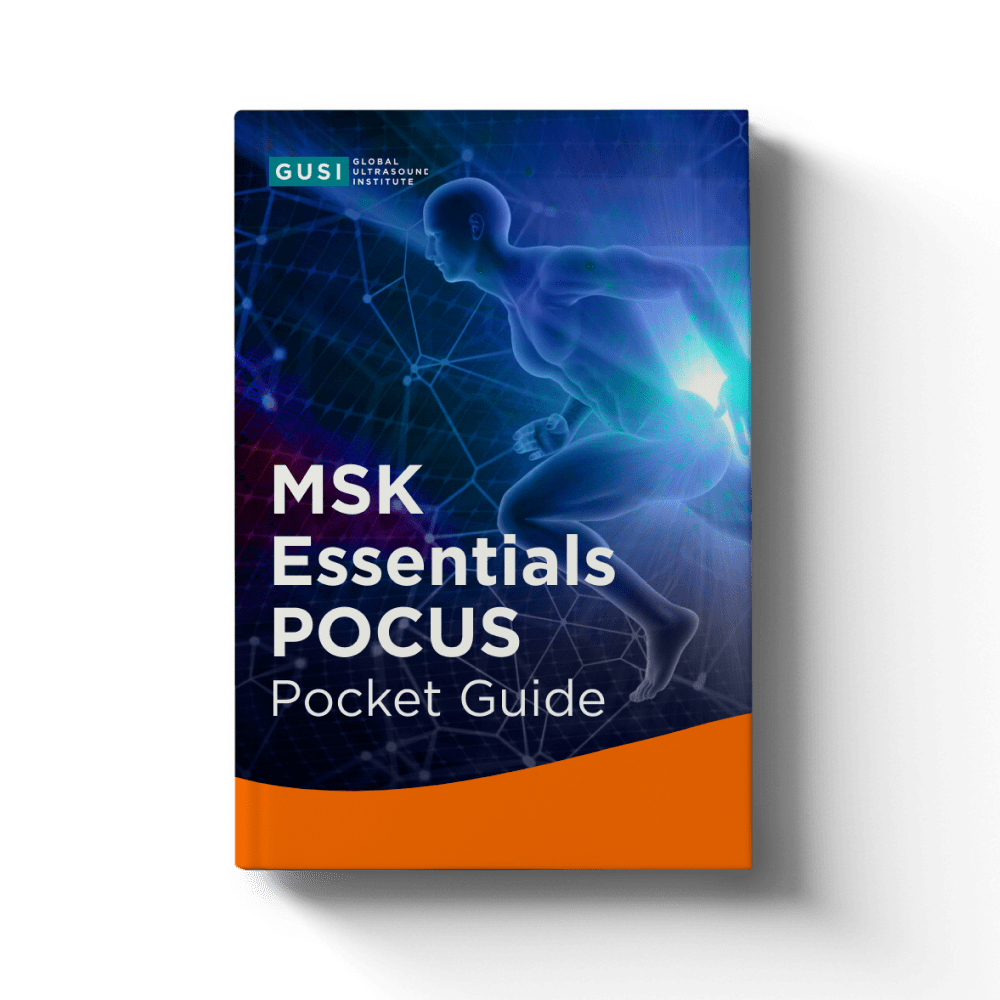
About the Guide
The GUSI MSK Essentials POCUS Pocket Guide is a compact, easy-to-use reference designed to support clinicians at the point of care. Whether you’re in primary care, sports medicine, orthopedics, or rheumatology, this guide provides quick access to essential musculoskeletal ultrasound protocols and best practices.
Covering the major joints and soft tissue structures (shoulder, elbow, wrist/hand, hip, knee, and ankle/foot), it helps ensure accurate image acquisition and interpretation for common MSK complaints including tendinopathies, tears, effusions, and inflammatory conditions.
Developed by the Global Ultrasound Institute (GUSI), this pocket guide is the perfect companion to GUSI’s MSK Essentials Course, reinforcing your learning and helping you confidently integrate MSK ultrasound into your clinical practice.
What You’ll Discover
✅ Anatomically organized scanning protocols for all major joints
✅ Clear probe positioning and patient positioning for each view
✅ Key anatomical landmarks and common pathology identification
✅ Normal versus abnormal imaging comparison
✅ High-quality ultrasound images with labeled structures
✅ Clinical pearls and scanning tips for optimal image acquisition
Book Overview
Comprehensive MSK ultrasound protocols organized by anatomical region for quick reference and clinical confidence.
SHOULDER ULTRASOUND
Systematically evaluate anterior, superior, lateral, and posterior shoulder structures including the rotator cuff (supraspinatus, infraspinatus, subscapularis), long head of biceps tendon, and acromioclavicular joint to diagnose tears, tendinopathy, impingement, and instability.
ELBOW ULTRASOUND
Assess the lateral elbow including common extensor tendon, radial collateral ligament, and joint spaces to diagnose lateral epicondylitis (tennis elbow), tendon tears, joint effusions, and radial head pathology.
WRIST ULTRASOUND
Examine the volar wrist structures including median nerve and carpal tunnel, along with the first dorsal compartment (De Quervain’s) to identify nerve compression, tenosynovitis, tendon tears, and inflammatory conditions.
What Makes This MSK Pocket Guide Special
Portable, practical, and proven. Designed by MSK ultrasound experts for clinicians who want to deliver better musculoskeletal care.

Point-of-Care Diagnosis
Evaluate MSK complaints in real-time during patient visits. Reduce the need to send patients for imaging. Assess tendons, ligaments, joints, and soft tissues immediately.

Anatomically Organized
Each joint section follows a systematic approach based on anatomical regions, making it easy to find the exact protocol you need during clinical encounters.

Clear Visual Guidance
High-quality ultrasound images with labeled anatomical structures help you quickly identify normal anatomy and recognize pathology like tears, effusions, and inflammation.

Primary Care Focused
Specifically designed for non-radiologists and clinicians who want to integrate MSK ultrasound into everyday practice. No specialized training required to get started.

Dynamic Assessment
Learn proper probe positioning and patient movement techniques to assess tendons and ligaments dynamically, revealing pathology that static imaging might miss.

Common Pathology Recognition
Quick-reference guides for identifying tendinopathy, partial and full-thickness tears, bursitis, joint effusions, ligament injuries, and nerve compression.

GUSI-Tested Protocols
Developed by Global Ultrasound Institute educators who’ve trained thousands of healthcare professionals in practical, evidence-based MSK ultrasound techniques.

Course Integration
Perfectly complements GUSI’s MSK Essentials Course, providing a hands-on reference that bridges online learning with bedside application.
Trusted by MSK Clinicians Worldwide
See What's Inside: A Quick Walk-Through
Take a 2-minute tour of the GUSI MSK Essentials Pocket Guide and discover how it can transform your approach to musculoskeletal care.
From cover to cover, this pocket guide is designed with one goal: to make MSK ultrasound accessible and actionable in everyday clinical practice. Watch this brief overview to see how the joint-by-joint protocols are organized, explore sample pages with annotated ultrasound images showing normal anatomy and common pathology, and learn how this resource integrates with GUSI’s comprehensive MSK ultrasound training.
Whether you’re evaluating shoulder pain, knee injuries, or wrist complaints, having evidence-based scanning protocols at your fingertips enables same-visit diagnosis and treatment planning. See for yourself how this portable guide delivers exactly what you need to confidently incorporate MSK ultrasound into your practice.

Didn’t find your answer?
No worries! If you have any other questions or need more information, feel free to reach out directly.
Have more questions? Send us a message.
Frequently Asked Questions
What joints and structures are covered in this MSK pocket guide?
The guide provides comprehensive coverage of all major joints: shoulder (rotator cuff, biceps), elbow (common extensors/flexors, collateral ligaments), wrist/hand (tendons, carpal tunnel), hip (joint, bursae, tendons), knee (quadriceps, patellar tendon, collateral ligaments, effusions), and ankle/foot (Achilles, plantar fascia, anterior/lateral tendons).
How does this pocket guide complement GUSI’s MSK Essentials Course?
This pocket guide is the perfect companion to GUSI’s MSK Essentials online course. While the course provides comprehensive video instruction and scanning techniques, this guide serves as your portable reference during actual patient encounters, helping you recall proper probe positioning and anatomical landmarks when you need them most.
Can I use this guide for ultrasound-guided injections and procedures?
Yes! The guide includes detailed anatomical views that are essential for safe, accurate ultrasound-guided procedures. Understanding normal anatomy and optimal probe positioning is critical for successful guided injections, aspirations, and other interventional techniques.
What type of ultrasound machine do I need to use this guide?
The protocols in this guide can be used with any ultrasound system, from portable handheld devices to cart-based systems. The scanning techniques and anatomical principles apply regardless of your equipment. A linear high-frequency probe (typically 7-15 MHz) is recommended for most superficial MSK structures.
Do I need advanced ultrasound training to use this guide?
Not at all! This guide is specifically designed for family physicians, midwives, OB/GYNs, and emergency medicine clinicians who want to integrate obstetric ultrasound into practice. The clear protocols and labeled images make it accessible for beginners while remaining valuable as a reference for experienced practitioners.
More Pocket Guides

POCUS Essentials Pocket Guide
The GUSI POCUS Essentials Pocket Guide offers essential ultrasound reference information across specialties, improving diagnostic efficiency and supporting clinical decision-making on the go. Take the POCUS Essentials Course to master core ultrasound techniques.Learn More
OB Essentials POCUS Pocket Guide
The GUSI OB Essentials POCUS Pocket Guide provides portable, quick-reference ultrasound insights for obstetric care, empowering clinicians to make accurate, real-time diagnostic decisions. Enhance your expertise with the Obstetrics POCUS Essentials Course.Learn More
MSK Essentials POCUS Pocket Guide
The GUSI Musculoskeletal Essentials POCUS Pocket Guide is a portable, quick-reference tool for musculoskeletal ultrasound, offering essential knowledge for fast, accurate diagnosis of musculoskeletal conditions. Complement your learning with the Musculoskeletal Essentials POCUS Course.Learn More

Ready to Elevate Your Prenatal Care Skills?
Join 18,000+ clinicians worldwide who trust GUSI for evidence-based ultrasound education.
The GUSI MSK Essentials POCUS Pocket Guide puts comprehensive joint assessment protocols at your fingertips, helping you deliver faster, more accurate diagnoses for musculoskeletal complaints. Whether you’re evaluating an athlete’s shoulder injury, a patient’s chronic elbow pain, or an elderly patient’s knee effusion, this portable reference ensures you have the guidance you need, exactly when you need it.
Stop referring patients for imaging you could perform yourself. Start providing same-visit diagnosis and treatment planning that improves patient satisfaction and outcomes.
Designed by experts, tested in real clinical settings, and trusted by healthcare professionals across 250+ institutions worldwide. This is more than a pocket guide. It’s your confidence in MSK care, portable.










